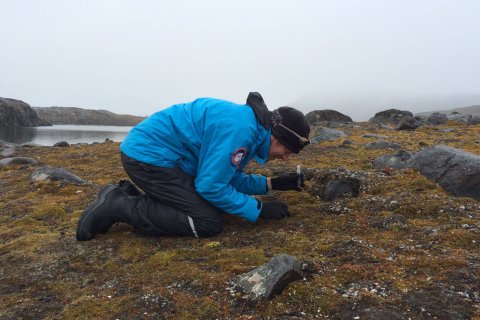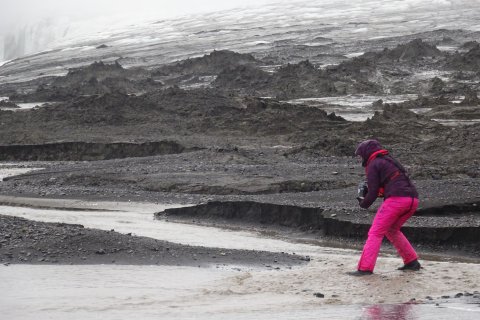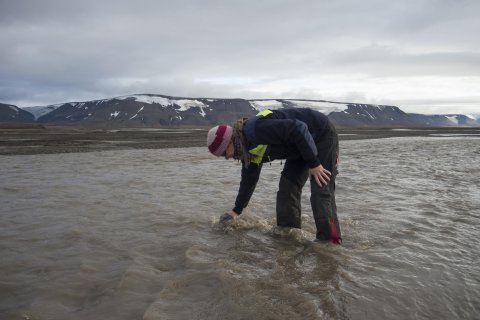“I would recommend coming along to every scientist”
Expedition to Spitsbergen: useful and relatively inexpensive
Among the 50 researchers who went on an expedition to Spitsbergen this summer were seven scientists from Utrecht. Researchers Wim Hoek (Physical Geography) and Willem Jan van de Berg (IMAU) came back with enthusiastic stories to tell.
“It would be great if these kinds of broad multi-disciplinary expeditions were organised more often, and I would recommend coming along to anyone”, said earth scientist Wim Hoek.
CLIMATE CHANGE
Although the researchers study the climate on a daily basis, the scientists were still shocked by the effects of climate change on Spitsbergen. The photo taken of an emaciated polar bear by one of the expedition members has become an iconic image, but the reindeer there are also suffering, explains climatologist Willem Jan van de Berg. “During the cold winters of the past, the reindeer could push aside the snow to graze on the moss underneath. Now that the snow often melts and then re-freezes, the animals cannot reach the moss, so we saw much fewer reindeer than in the past. Explaining the consequences of climate change is not our main job, but after a trip like this we feel a responsibility to do so anyway.”
PRISTINE CLIMATE ARCHIVE
Hoek studies the climate of the past by examining the archive of the soil. “When we do this work in the Netherlands, we miss the data from the Roman era and the Middle Ages, because the peat from that time has been dug up and burnt for fuel”, he explains. “Spitsbergen is a pristine climate archive, because humans have never settled there. During the expedition I took core samples of lake bottoms that went back more than 2,000 years. Together with measurements that provide more recent climate information and other benchmarks, hopefully we will be able to reconstruct the climate of the past two millennia.”
NEW WEATHER STATION
Van de Berg conducts research into the climate above the polar ice caps, including the interaction between the weather conditions and the ice cap itself. “The condition on the surface of the ice cap is very important for those interactions”, he explains. “Snow is white, so it reflects light. When the snow melts and clumps together, it becomes darker and absorbs more light - and therefore heat - so the ice melts faster. During the expedition, we set up a new weather station on Spitsbergen in order to better understand how glaciers melt. The station will allow us to register the weather conditions, but also how much heat makes it to the surface of the glacier. We will also be able to measure how much the station sinks over time. That will allow us to reconstruct the effects of the weather conditions on the glacier.”
COOPERATION
The cooperation between the researchers felt natural, says Van den Berg. “Once we put up our weather station, we didn’t have much more to do for the rest of the expedition, so it was fun to help other people.” Hoek: “You need a whole team of people to take core samples, so Stefan Ligtenberg from IMAU joined us for a day to help drill cores. Plus, a joint expedition is relatively inexpensive, because you can share the logistical costs with lots of other researchers.
LEARNING EXPERIENCE
The researchers were pleasantly surprised about the effect of an expedition together with people from other specialisms. Hoek: “I enjoyed explaining our work to researchers from other disciplines. You actually learn more from those interactions than from colleagues from our own field, whom you normally work with every day. And the tourists who came along for the ride asked completely different questions. It’s great to realise how many people are interested in your research. I am pleased with the attention the media paid to our expedition. It lets you talk about your research in a more natural manner.”
CROSS-POLLINATION
The expedition also led to unexpected cross-pollinations of one anothers’ work. Van de Berg: “We do projects where we look back into the past, and during the expedition we realised that we can benchmark the information we collected on Spitsbergen to Wim Hoek’s data.” Hoek: “I talked to some biologists, who say that they see clear differences with observations from the 1970s. We should be able to see those differences in our results as well.” Van de Berg: “Strangely enough, we found that there was actually little change over the past 50 years. It will be interesting to find out why that is.”
MORE INFORMATION
SEES-blog by Willem Jan van de Berg
SEES-blog by Wim Hoek
NOS-blog by Peter Kuipers Munneke
Photo Gallery

Peter Kuipers Munneke
“It’s not a very impressive photo, but it is one that perfectly depicts the atmosphere of teamwork and a common goal that typified this polar expedition. On the photo, you can see me while I look for insects in the moss between two entomologists, so that we could put them in a test tube with alcohol. For me, one of the most special parts of the trip was meeting other polar researchers. The common ground for us was the polar regions, not a single field of study. We learned a lot from each other during the trip, and we helped one another whenever we could.”

Keechy Akkerman
"We took a core sample under the supervision of a polar bear lookout, who kept an eye on everything in the background. With this core sample, taken in an area that is virtually untouched by human activity, we hope to go back in time to reconstruct the effects of climate change using chemical and biological indicators preserved in the core. One example of these indicators is diatoms, which are very sensitive to changes."

Elise van Winden
"We carried empty bottles to calving glaciers and meandering rivers flowing over the tundra or through ancient moranes. The water and ice will be taken to Utrecht and measured for the amounts and types of organic material and sediment content, the origins of the melt water and the degradability of the organic material for organisms."

Stefan Ligtenberg
“This photo was taken on the last day of the expedition, in Hornsund, a fjord on the southwestern coast of Spitsbergen. It certainly isn’t my best picture, but it is the place that made the biggest impression on me. I was standing on the bridge next to Ko de Korte, one of the people who wintered there in 1968/69, enjoying the 360-degree panorama view of 6-7 glacier fronts, when he suddenly said: “I was here 49 years ago, and back then this whole fjord was filled with glacier ice. Where the boat is now was in the middle of the glacier back then.” Over the past few decades, this glacier has lost more than 15 kilometres in length, and has retreated from a single glacier into six smaller ones. That is the most impressive example of climate change that I’ve seen with my own eyes so far.”

Willem Jan van de Berg
“During SEES, Stefan Ligtenberg, Peter Kuipers Munneke and I installed an automatic weather station on Ulvebreen. The Ulvebreen glacier is retreating rapidly, just like all of the other glaciers on Spitsbergen, due to global warming, which makes glaciers melt and lose mass. We could clearly see that Ulvebreen was retreating while we were there. What impressed me was how ‘dirty’ the glacier was; it was covered with rocks and grit. But it made me realise that the days when the glaciers melt the most are not the sunny days, but rather the overcast but warm ones like the day we were working on the glacier.”

Jorien Vonk
“With rising temperatures at the poles, we see that the glacier volumes are receding rapidly, which results in more melt water draining into the rivers. These rivers carry organic material into the oceans, where it forms an important source of nutrients for the tiniest forms of sea life. The prognosis is that more melt water will have an influence on the amount of organic material transported to the ocean, and we are going to study whether that is the case!”

Wim Hoek
“During the SEES expedition, we took core samples of lake bottoms with our ‘core drilling boat’ on both Barentsøya and Edgeøya. This picture of me and Lineke Woelders (University of Leuven) shows one of the core samples we took in the lakes near Russebukta on southwest Edgeøya. It is known that the accumulation speed in these lakes is very low, sometimes just a few centimetres in a hundred years, because of the short summers. We hope to determine the history of the climate and vegetation of the last 2000 years from core samples like this one. In the field, the core sample was cut into smaller samples of half a centimetre, that will be further examined in Utrecht and Leuven during the next months.”

